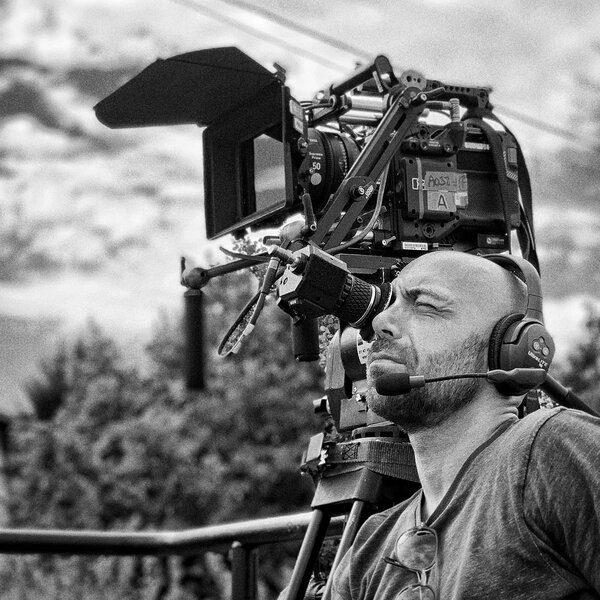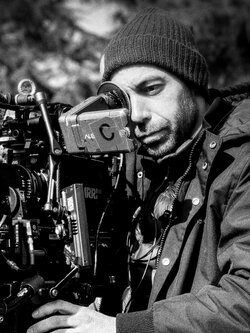Eric Dumont, AFC, discusses his work on "Suprêmes", by Audrey Estrougo
A biopic about the birth of the emblematic French 90s rap group, Suprêmes NTM. The film recounts the group’s beginnings in 1988 through their concert at the Zénith in 1992.
With Théo Christine (Joey Star), Sandor Funteck (Kool Shen), Félix Lefebvre, César Chouraqui.
Is this your first time working with Audrey Estrougo ?
Éric Dumont : “Non”, it’s the second time, but the first film I shot with her, À la folie, hasn’t been released yet. That film was shot in secrecy, in ten days, it was very personal and produced independently, which is totally different from Suprêmes.
For this biopic, did you try to hew closely to reality, both in terms of the story and the time period ? Please tell us a bit about preproduction on the film.
ED : The actors worked on preparing the film for two years. They worked on the singing, the dancing and the gestures of the "real" characters. All of the concert scenes were shot live. The sound mixers and the people who shot NTM’s actual concerts came on set as consultants and they really felt like the group was actually there, revived. We stopped preparations almost as soon as they’d started because of lockdown, but that meant that we had a lot more time for the artistic direction. During this very valuable time, we did an enormous amount of research, we really went deep into the time period, the costumes, the colors, the ambiences. We shot just after things opened up again, between the two waves. It wasn’t easy to shoot concert scenes with hundreds of extras in the middle of a global pandemic.
Did you have references for building the aesthetics of the film ?
ED : Audrey wanted a film with panache, but in the modern, contemporary sense of the term. One of her inspirations was a film by Todd Phillips, Joker, which I watched several times. My other important visual reference was Descente interdite, a photo book about the history of graffiti in the Paris Métro in the 1980s. I had to turn towards an aesthetic that avoided the reflex of a period film, where one might turn to a VHS-type rendering with its attendant graininess, an old, slightly dirty image. We decided to opt for a strong artistic presence that wasn’t necessarily realistic.
Could you summarize that artistic presence ?
ED : Green nights, which are atypical ! Working with underexposure and allowing darkness to exist and causing shine. Taking risks, and even causing accidents on purpose.

And in order to accomplish your goal, let’s talk about the "Supremes"
ED : [Laughter] Yes ! I chose the Zeiss Supreme lenses for this film. At the manufacturer’s request, I shot a short promotional film and I was completely charmed by the lenses. I am used to working with older lenses, which are a bit fleshier and have aberrations, such as the K35s or the Mamiyas, which I adapt for wide format sensors.
The Zeiss Supreme lenses also cover the full format. The particular finishing on the Suprime Prime Radiance series is very interesting ; it brings a blue dominant into the flare. The rendering is close to some anamorphic lenses, such as the C-Series or the G-Series by Panavision. Those lenses are very bright, but they are also sharper and more modern. I used them with a lot of smoke on set to soften them.
Suprêmes is a film that emits a lot of energy and a vital pulse that can be felt in its photography. The actors’ performance and the editing contribute to that feeling, but does the way it was filmed also ?
ED : There is a lot of concert scenes shot from the shoulder, sometimes with two cameras placed side by side, not in shot/reverse. But there was a lot of Steadicam, also, almost always with a long focal length. I chose to avoid the floating feeling a Steadicam gives, and tried to produce a result closer to a traveling shot in order to counterbalance the shots filmed on the shoulder. I work a lot with Thomas Burgess, who is excellent at long takes, of which there are many in Suprêmes. For example, we shot Didier’s arrival at his father’s birthday party as a long take, from behind, and we did the same for the whole scene where he begins to dance. Then everything stops and we shot the confrontation between father and son on a stand, with a still camera in long focal length, like in a Western.
Another scene between Didier and his father is filmed like a Western…
ED : Right ! It’s frontal, square, glacial… like their relation.
That marks the difference with the rest of the film and that’s why it works so well.
The grandiose scene at Mantes-la-Jolie is magnificent and it’s another long take. How did you shoot it ?
ED : At first, the scene is in total darkness, a darkness that is so deep that it can be disturbing. Then, the convertible Golf arrives and it lights the center of the scene. Then the other cars arrive, and their headlamps add light. These cars were outfitted with special lights to reproduce the look of headlamps from that time.
For the backgrounds, oilcans were outfitted with flame ramps. The entire neighborhood is lit with 4 kWHMIs with green gels, bouncing on large canvases. We added real sodium streetlamps from the period, which we specially sourced for the film. A large light box was built with 12 SkyPanel S360s (1m x 1.20m), which we set up on a 100-meter-tall crane to recreate the moon. In fact, I don’t like the feeling night light gives, so I always make it so that it comes from as high up as possible and that it be as diffuse as possible.
We had a big lighting set-up that day, with extra sparks brought in and kilometers of cables, and a huge generator ! The beginning of the scene was filmed with a Steadicam set up inside the car, and then it gets out of the car, and lastly it goes onto the Akela Crane which brought it up 25 meters into the air. The ending wide shot shows the entire scene, with the entire neighborhood in the frame.
The texture of the image participates in the strong artistic statement the film makes.
ED : As to break up the video effect, I exposed most of the scenes that day at 1,600ISO, and some night scenes at 2,500ISO. Later, I scanned a true 35mm grain that was then added to the images with different loops to reproduce the randomness of celluloid.
Was Suprêmes a positive experience for you ?
ED : Yes, it was a great experience with very radical artistic choices and a different aesthetic from other projects I’ve lit. I am really satisfied with the fantastic teamwork that began with Audrey and was seen through by the set and costume designers, and of course, the camera crew, the grips, and the gaffers…
(Interview conducted by Brigitte Barbier and translated from French by A. Baron-Raiffe for the AFC).
Above, and in the portfolio below, on-set photos taken by members of the crew.
 En
En Fr
Fr






